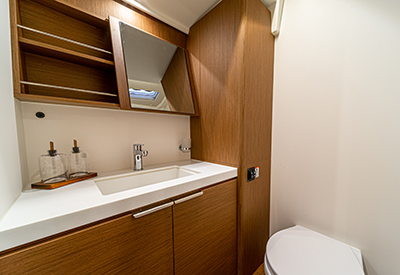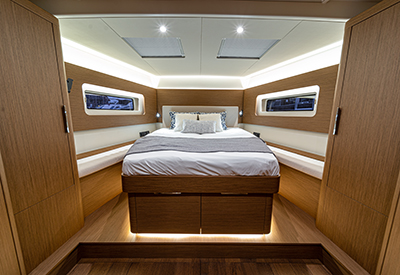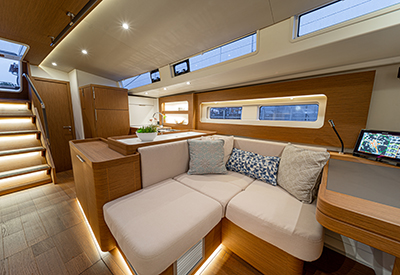Beneteau Oceanis Yacht 54
By Zuzana Prochazka
A seductive grand dame
Beneteau saw an opportunity to add a little thrill to any cruising adventure, so they took the hull of the First 53 racer (introduced just last year), and with a few fashionable changes, created the Oceanis Yacht 54, the new entry-level of Beneteau’s swanky Oceanis Yacht line. The result is a performance cruiser that sails like a witch and looks like a grande dame.
Design
Roberto Biscontini is the naval architect and Lorenzo Argento created the details of the exterior and interior design. Biscontini’s America’s Cup experience created a balanced hull with a carefully positioned center of buoyancy. The hull is modern and minimalist with a plumb bow, a vertical and open transom, a low coachroof, and a beam that is carried all the way aft.

The cockpit is the star of the Oceanis 54 exterior. It’s a very posh affair with plenty of room for 10 people or more even under way.
Construction
The construction combines fibreglass stringers that are fixed to an aluminum substructure and a hull that’s cored with balsa to the keel. She gained about a ton over her racing predecessor but that’s a rounding error when you add on the usual full tanks and a load of cruising gear.
Topsides
The aluminum, deck-stepped Sparcraft rig has two versions: standard air draft at 78’ 9” or the performance mast that adds another 5’ 11” and 33% more sail area. Sail combinations include a self-tacking jib or 105% genoa (which is what our test boat had) and a furling mainsail although a classic, fully-battened main is an option. The sheeting angles are tight and with the composite sprit, you can add a Code 0 or a full spinnaker.
There’s nothing on deck to catch a lazy sheet. Six pop-up wing cleats fold down neatly and the Lewmar windlass is mounted below deck. The bulwarks are high to provide good footing when heeling. Since the stanchions are mounted on top of these bulwarks, the lifelines are high as befits an offshore vessel. By contrast, the cabinhouse is low, almost more of a suggestion than a real structure, so the deck feels elongated and the visibility forward is exceptional.
There are also two choices of keel: standard at 8’ 2” and shoal at 6’ 7” which is what our test boat had fitted. Combined with twin rudders, the Oceanis Yacht 54 is perfectly balanced. Once she finds her groove, you can take your hands off the wheel or steer with one finger.
The cockpit is a stunner and superyachts have nothing on Argento’s posh layout. The social area is ahead of the wheels and out of the way of working crew. Instead of one cockpit table in the center, there are twin smaller tables on either side, which opens up a path from the companionway to the transom. Long lounges under the dodger and on either side of the companionway will be the place to relax in the evening and watch the stars above.

It’s easy to skimp on stowage spaces in the heads, but Beneteau dialled it in with Oceanis 54.
Twin angled binnacles hold the wheels and slim dashboards with 12-inch B&G MFDs. Engine controls are on top of the binnacle rather than at knee level, which makes docking simpler. The entire working cockpit is on a single level, so it’s easy to move between the wheels and the aft deck provides a great place to observe all the action but still stay out of the way. From the aft end, you can walk all the way to the bow with just one step up. It’s a very civilized way to reach the side decks making crawling over the cockpit coaming a distant memory.
Four Harken winches manage the lines which are led aft to the helms where the driver can manage them easily while sitting astride the small, outboard seat. A dinghy garage is tucked into the aft end of the hull and it’s accessible via a cockpit hatch, or when the transom is lowered electrically. It will hold an eight-foot inflated RIB or a nine-foot deflated one.
 Layout & Accommodations
Layout & Accommodations
A very civilized approach to the interior is separating the lounge from the dinette – a rarity on sailboats under 70 feet.
The Oceanis Yacht 54 is a semi-custom build, which means you can personalize much of the interior by swapping in equipment like a bottle fridge, a dishwasher or a generator. You can also tinker with the furniture and add a nav station in the forward port corner of the saloon.
The layout on our test boat included three cabins and three heads with the master suite in the bow. You can forego the port head and elongate the galley which seems like the right choice for those who want to entertain aboard. A crew cabin can be added in the bow.
Below, as on deck, the approach is minimalist with necessary functionality tucked away discretely. Beneteau’s Ship Control, a highly customized Schreiber digital switching system, reduces the number of visible switches and controls. Appliances are hidden behind panelling and the seating is multifaceted so additional people can be accommodated for an elegant dinner.
There are two steps that interrupt an otherwise flat cabin sole. One step down is into the galley and the other is into the master stateroom. Here you’ll find a large island berth, a split head and shower, an impressive amount of stowage space and plenty of light from the hull windows as well as his and hers overhead hatches.

The master suite is downright opulent with great indirect lighting and his and hers hatches overhead.
Our test boat had a darker walnut finish, but a light oak colour is also available. A detail worthy of mention is the double rail at the companionway that came in handy when we moved in and out of the boat in gusty conditions.
Under Sail
It’s a delight to report that for once, we had the perfect conditions for a test sail. Warm sun, flat water and a breeze of 15-20 knots allowed us to sail the bejesus out of this yacht. In 17 knots of true wind, we made 9.1 knots at 65 degrees apparent wind angle. When we hoisted the Code 0 and fell off to a beam reach, we topped out at 10.2 knots of boat speed and we never reefed. She’s slippery and exhilarating and the one thing an owner will never be with this yacht, is bored.
We were on our ear almost right off the dock and bracing in the cockpit took concentration. This may appeal to some, but it can be a sporty ride for cruisers used to keeping their gear and bodies in place. For those who like a boat that looks like she’s got a bone in her teeth, this will be a plus.
Under Power
Our boat was fitted with the upgraded 110-hp Yanmar turbo diesel and a straight shaft although standard propulsion is a Yanmar 80-hp with Saildrive. The larger engine makes this big boat nimble and the retractable Sidepower bow thruster helps in narrow fairways and tight slips. Beneteau’s Dock & Go joystick steering system is an available option with the 80-hp engine, but with just a thruster, she’s quite maneuverable and turns on a dime even without the upgrade.

A desk dedicated to ship’s business is key, especially for those living aboard or making extended passages.
We motored at 9.2 knots and 3300 rpm at wide-open throttle. A more economical cruise can be found at 8.6 knots and 2400 rpm.
Overall Impressions
Given her racing origins, it’s no surprise that the Oceanis Yacht 54 is an exciting boat that delivers a fast cruise.
Specifications
LOA: 56′ 2″
LWL: 50’ 6”
Beam: 16′ 5″
Draft: 6’7”, 8’ 2”
Displacement: 36,586 lbs.
Air draft: 78’ 9” (+5’ 11” for performance rig)
Sail Area: 1,378 sq. ft. (with furling mainsail)
Fuel/Water: 106/190 gallons
Engine: Yanmar 80 w/ Saildrive or110 HP w/ shaft
Designer: Biscontini Yacht Design
Builder: Groupe Beneteau
As tested price: $861,000 USD






















